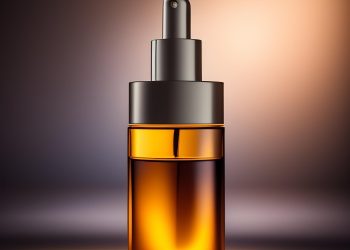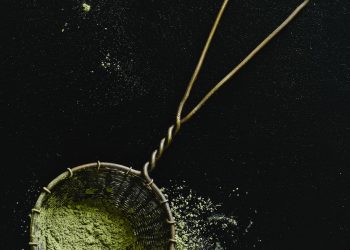Scleroderma is an autoimmune and chronic skin disease that is incurable and a problematic medical condition to live with.
Luckily, you can use essential oils for Scleroderma to manage some of the symptoms. These oils can also improve your quality of life to a great extent.
The term ‘scleroderma’ comes from the Greek words ‘sclerosis’ (hardness) and ‘derma’ (skin). Scleroderma means “hard skin.” It is also known as a rare form of rheumatic and connective tissue disorder. [1]
You may detect scleroderma with tightened and thickened skin on the face and hands. [2]
In scleroderma, your immune system produces more collagen or connective tissues in the body.
This abnormal growth of collagen has adverse effects on the skin, internal organs, and digestive tracts of your body.
More than 75000 people in the U.S.A. have scleroderma. Scleroderma causes disability, shortened life expectancy, mental distress, and depression.
This article reviews the efficacy and use of some essential oils for scleroderma, plus the types, causes, and symptoms of this chronic skin disorder.
5 Best Essential Oils For Scleroderma
Scleroderma affects a wide range of organs and systems. There is no single remedy for this rare and challenging medical condition. [3]
Essential oils can be an effective natural remedy to cut negative impacts on the body.
These oils may help manage both the physical and emotional aspects of the disease. These oils can also relieve scleroderma symptoms effectively.
1. Frankincense Oil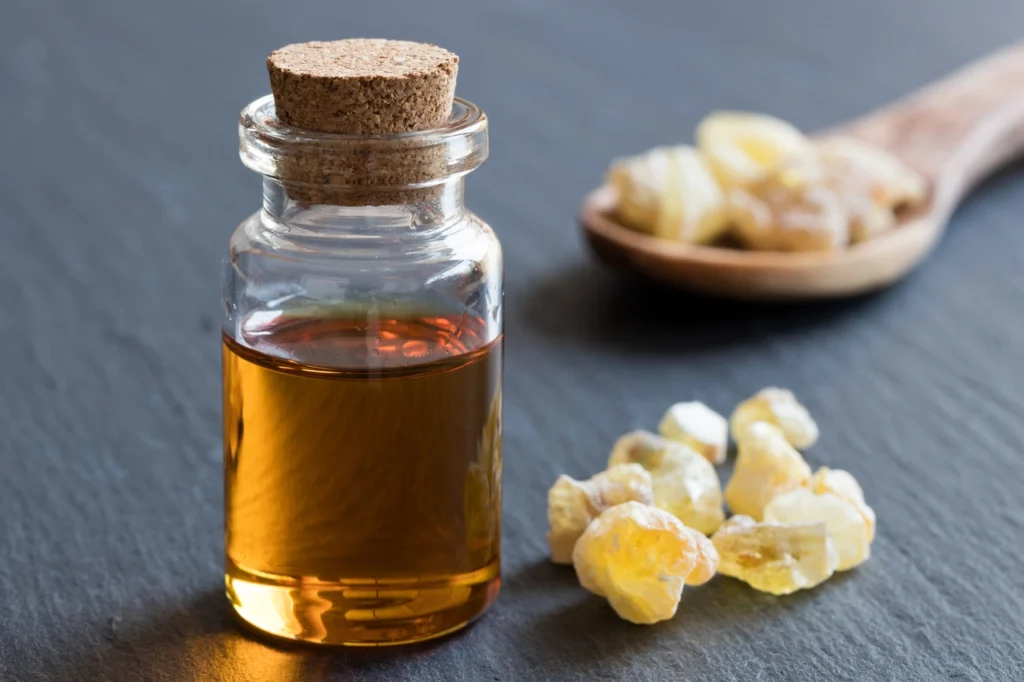
Frankincense oil comes from the distillation of the oleoresin of Boswellia trees. [4]
Frankincense is a sacred ingredient in many cultures. The sweet and earthy aroma of the oil has a calming and relaxing effect on your body and mind.
The essential oil is rich in anti-inflammatory, expectorant, and anti-anxiety properties. Hence frankincense oil can relieve stress and inflammations associated with scleroderma symptoms. The oil can provide you with a sense of well-being.
How to use frankincense oil for scleroderma:
You can use this oil for aromatherapy, massage, or a hot bath to manage scleroderma symptoms.
Read More: 12 Health Benefits and Uses of Frankincense Oil to Know About
2. Lavender Oil
Lavender oil is one of the most potent essential oils with versatile uses. The herbal oil originates from the steam distillation of the aromatic lavender flowers.
Lavender oil has a sweet and calming aroma. It is full of antioxidant, analgesic, anti-anxiety, anti-inflammatory, antidepressant, and expectorant properties [5].
Thus, it can relieve stress, insomnia, fatigue, and headaches due to scleroderma.
Here is a simple method of using lavender oil for scleroderma:
A lavender oil massage can reduce skin inflammations. It can induce sound sleep during the time of scleroderma difficulties. [5]
Read More: 11 Health Benefits of Lavender Oil That You Should Know
3. Lemongrass Oil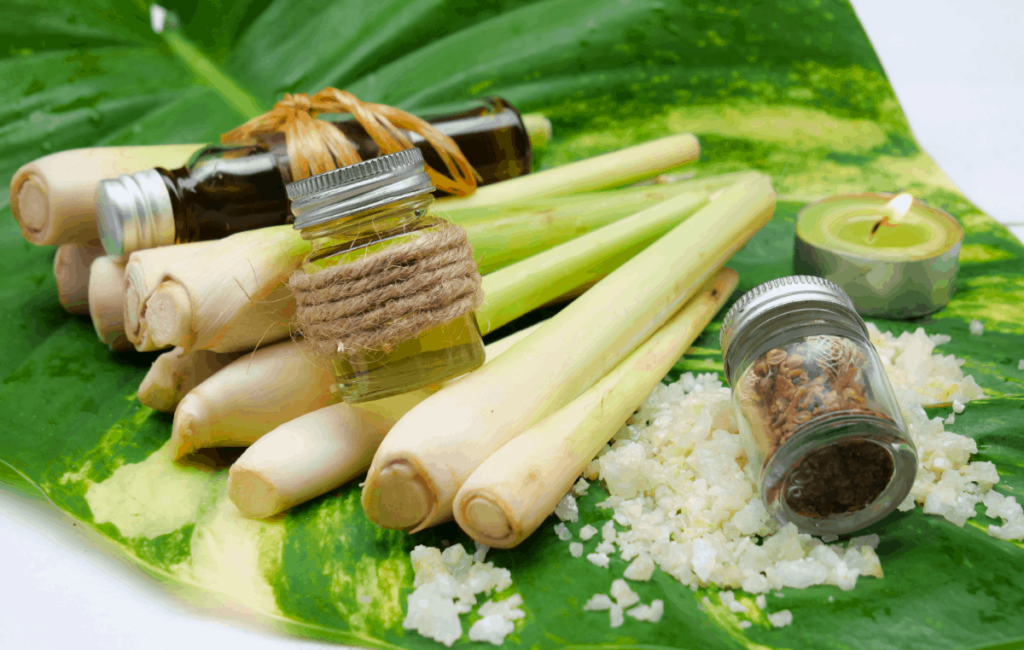
Lemongrass oil comes from the spiky aromatic leaves of lemongrass plants. The yellow herbal oil has a mind-blowing lemony scent.
The therapeutic oil is rich in analgesic, anti-inflammatory, anti-depressant, and anti-anxiety components. [6]
Easy methods of using lemongrass oil for scleroderma:
Take a lemongrass oil massage or a hot bath to relieve symptoms caused by scleroderma. These include pain, stress, sleeplessness, and circulatory disorders.
Read More: 14 Effective Essential Oils for Fever & How to Use Them
4. Peppermint Oil
Peppermint oil is famous for its menthol flavor. The peppermint herb is a combination of spearmint and watermint plants. [7]
Peppermint oil has high menthol content. This component makes it an authoritative source of anti-inflammatory, analgesic, anti-stress, and antidepressant properties.
Peppermint oil can relieve the puffy and swollen fingertips and toes. It can calm down the pain and manage circulatory problems in the body.
The oil contains rosmarinic acid. It helps you treat the shortness of breath associated with scleroderma symptoms.
How to use peppermint oil for scleroderma:
Massage a few drops of peppermint oil to get rid of the symptoms of scleroderma.
Read More: 12 Uses and Health Benefits of Peppermint Oil
5. Roman Chamomile Oil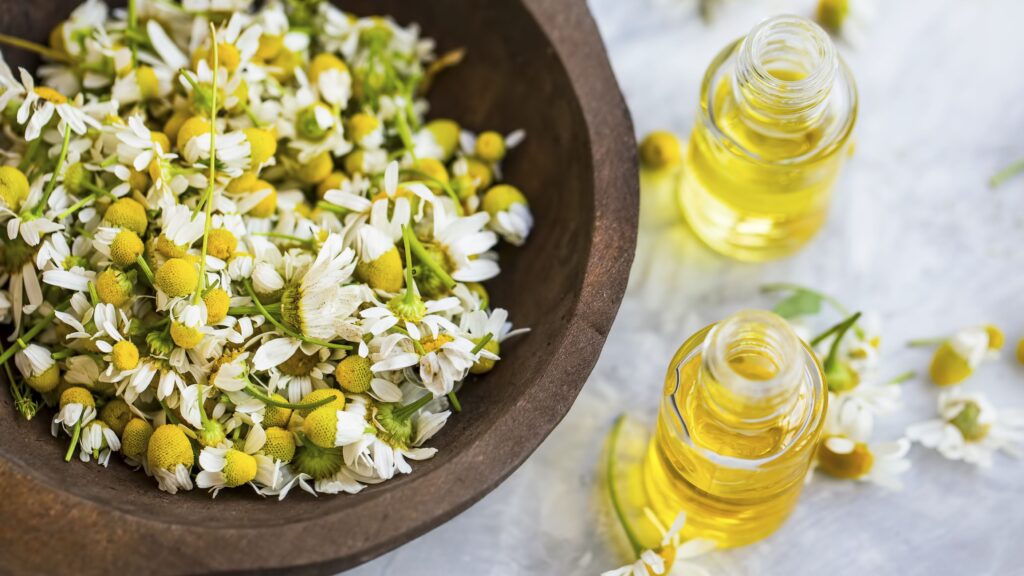
Roman Chamomile oil comes from the blossoms of the chamomile plants. It is a great aromatic oil that acts as a stress reliever and mood enhancer.
The herbal oil has sedative, anti-depressant, and anti-inflammatory properties. Thus, it can manage many scleroderma symptoms. [8]
A simple way of using roman chamomile oil for scleroderma:
The oil has a penetrating effect on your nervous system and brain. It can relax your muscles and joints pains, and headaches, and induce a sound sleep at night. Apply the oil to your affected areas to relax your muscles.
Read More: 5 Best Essential Oils for Alcoholism Addiction Recovery
Types Of Scleroderma
There are two types of scleroderma. Localized sclerodermas are the inflammations or thickening of your skin. This type of scleroderma occurs as morphea and linear forms of skin inflammations. [1]
Systemic scleroderma or generalized scleroderma affects the internal organs and bodily systems.
It might be genetic for a person to be susceptible to suffering from this autoimmune disease.
Women in their 30’s and 50’s are more prone to suffer from Scleroderma than men (the ratio is 4:1)
Scleroderma is a rheumatic condition. Because it causes a lot of pain and inflammations in the muscle and joints.
Read More: 5 Best Essential Oils for Schizophrenia Management
What are the Symptoms of Scleroderma?
Scleroderma causes mild to severe complications in some internal organs of the body. It disrupts the vital functions of your body. [2]
Some of the common symptoms that you have scleroderma are:
- You’ll observe patches of hard and tight skin on different parts of your body. Such as on the face, the hands, and on the upper trunk, etc. These patches may be straight lines or of oval shape.
- The skin patches differ in their location, size, and number based on the types of scleroderma.
- At an early stage, your fingers and toes will be extra sensitive to cold and emotional stress. Thus you’ll experience numbness, color changes (fingertips and toe turning red, blue, or white), and pain.
This symptom is also known as Raynaud’s phenomenon.
- Swollen and painful fingertips, toes, joints.
- Fatigue and weakness in the muscles
- Dryness of mouth and eyes is also known as Sjogren’s syndrome
- Difficulty in breathing.
- The problem in brushing teeth and lower production of saliva
- Erectile dysfunction in men reduced vaginal lubrication and constricted opening of the vagina.
- Diarrhea, heartburn or acid reflux, and weight loss
Read More: 16 Amazing Home Remedies for Chickenpox Scars
Precautions to Follow
Be extra careful while you are using these essential oils on your skin. Although they are natural, some of them are very strong. Thus, they may irritate your skin. That’s why you should always dilute them before using them.
If you have an allergy, or you’re pregnant, you mustn’t use any of the essential oil without asking your doctor. And, never forget to do a patch test before you start using essential oil.
When to See a Doctor
You can ease the symptoms of scleroderma with the help of some essential oils. But, if your symptoms don’t reduce after trying the home remedies, you must see a doctor.
It’s better to see a doctor who specializes in arthritis and other diseases of joints, muscles, and bone.
This condition may affect various organ systems. You need to consult a doctor based on that.
Bottom Line
Scleroderma is a chronic medical condition. You may undergo a difficult period of life because of this.
Essential oils may help you reduce your problems in this crucial journey. Using essential oils for managing scleroderma symptoms has no side effects if you know how to use them.
But, if you’re allergic to certain essential oil, you must not use them. Also, consult with a physician before you use any of the oils.
The National Centre for Biotechnology suggests using essential oils for scleroderma. The oils may provide relief from pains, skin inflammations, stress, sleeplessness, joint, and muscle immobility. [9]
Read Next: 10 Best Home Remedies for Endometriosis Backed by Science!



